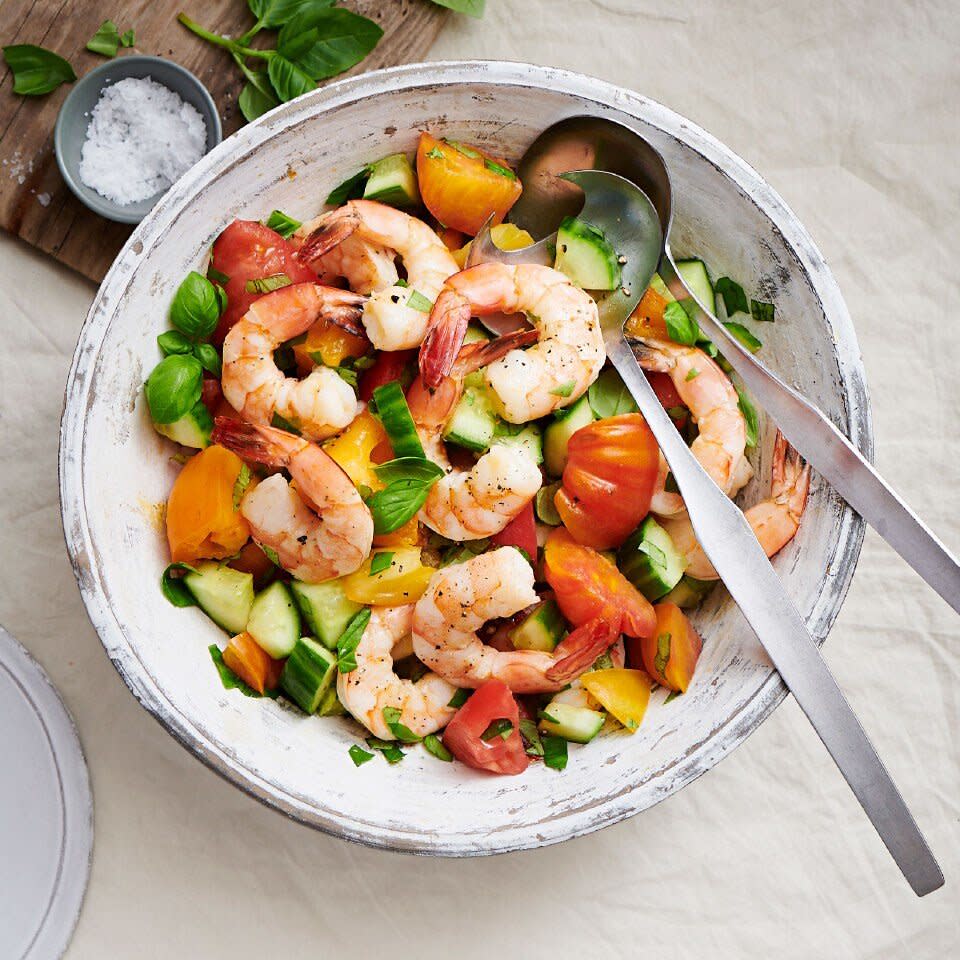Is Shrimp Healthy? Here's What a Dietitian Says
Shrimp is on the menu, but you're torn about ordering it. You love its sweet, fresh-from-the-sea flavor, but you've heard that it's maybe not so healthy. It's no wonder we question whether these little crustaceans are good for us when we hear the negative rhetoric around shrimp, mainly that they're high in cholesterol. So what's a shrimp-lover to do? See what a dietitian has to say about shrimp nutrition.

Shrimp Nutrition
Let's first address cholesterol. Shrimp are known to be high in cholesterol; however, research suggests that the cholesterol in food has little effect on our blood cholesterol. Meaning, that if you eat shrimp, it won't be detrimental to your cholesterol as was once previously thought. Jenny Shea Rawn, MS, MPH, RD, registered dietitian, content creator and seafood lover at JennySheaRawn.com agrees. She points out that "the saturated and trans fats we consume impact our cholesterol levels more than dietary cholesterol—and shrimp contains minimal saturated or trans fats." Here are the nutrition facts for a 3-ounce serving of cooked shrimp:
84 calories
20 g protein
0 g fat
0 g carbohydrates
161 mg cholesterol
0.4 mg iron
220 mg potassium
1.4 mg zinc
Shrimp are low in calories while also being a great source of protein. A 3-ounce serving of steamed shrimp supplies about 84 calories and 20 g of protein. Plus, the health benefits of shrimp are vast. Rawn explains that shrimp also contain "selenium (important for heart, immune and thyroid health) and iodine (important for thyroid health) as well as other essential nutrients, including Vitamin B12, zinc, copper, omega-3s and the antioxidant, astaxanthin."
Shrimp can be a nutritious choice, but it often comes down to preparation. Like other proteins, if shrimp are battered and fried or swimming in a pool of butter, they might do more harm than good for your health. However, shrimp that have been grilled, poached, steamed or baked are often a healthier choice. And when it comes to seasonings, stick with fresh herbs & spices, extra virgin olive oil and fresh citrus to boost flavor.
How to Choose Shrimp
Looking for the right shrimp for tonight's dinner? If you're confused about what all of those numbers mean, you're not alone.
Most recipes call for a certain size of shrimp, so it's good to familiarize yourself with what those numbers stand for. And it's easier than you might think—the numbers represent the amount of shrimp you'll get per pound.
So, for example, shrimp designated "16/20" means that you'll get about 16 to 20 shrimp in 1 pound. These sizes sometimes also come with names. So the same 16/20 shrimp can also be called "extra jumbo" shrimp. However, this language isn't regulated, so we recommend using the number per pound designation for best accuracy.
If you're buying frozen, Rawn recommends buying shell-on, uncooked (raw) deveined shrimp for the best flavor and texture. "Review the bag and check that the only ingredient listed is "shrimp," without any preservatives or additives," says Rawn, "And do a visual check of the bag. If it's torn or damaged, it's best to avoid it. Also, stay away from bags with lots of ice crystals which can mean the product has thawed at some point and then been re-frozen."
Finally, check to ensure the shrimp feel hard (still frozen!) and not soft (thawed!). And Rawn reminds us that frozen is just as good as fresh because "freezing methods have come a long way and most shrimp are flash frozen right after harvesting, which preserves texture and flavor."
When buying fresh shrimp, it's best to purchase from an informed seafood monger at your grocery store. Ask when the shrimp came in and how long they've been on display. Look to see that the shrimp you're buying is sitting on a bed of fresh ice—and don't forget to look and smell! Fresh shrimp should appear translucent and not give off a fishy odor.
How to Cook Shrimp
This quick-cooking protein is a fan favorite when it comes to quick dinners. Before cooking, we recommend deveining the shrimp first. Using a sharp paring knife, cut a small slit along the back of the shrimp to reveal the vein and pull it out. As for the shell, leaving it on or taking it off is a matter of preference. Leaving the shell on can be a good idea if you're new to cooking shrimp. The shell acts as a protective barrier, keeping the shrimp moist while preventing over-cooking. Rawn loves grilled shrimp—Tossed on salads or skewered for kebabs. Poached shrimp is also great for a variety of shrimp salads and shrimp cocktail. And nothing beats the classic—shrimp scampi served with toast points and a big salad.
Bottom Line
Research suggests cholesterol in food, including those found in shrimp, has minimal impact on blood cholesterol. Shrimp is highly nutritious and pairs well with a wide array of dishes. Be sure to browse our collection of healthy shrimp recipes for meal ideas and inspiration.

